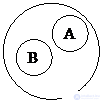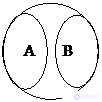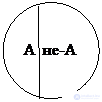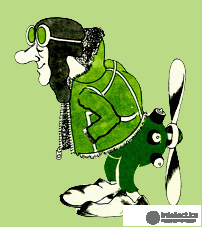Lecture
As noted during the consideration of the first topic of this lecture course, logic is directly interested not in any thinking, but only in abstract. The main forms of the latter are the concept, judgment and inference. It's time to get to know them in more detail.
A concept is an abstract thought that distinguishes an object as a system of all its essential (necessary for its existence) properties. The latter constitutes the content of the concept, and besides the content it has a volume - a subject corresponding to the content.
The role of volume can be played by a single item, and then the concept is called a unit (for example, the concept of the Earth), or an arbitrary element of the set, and then the concept is called general (for example, the concept of a planet). For a single concept, a graphic image of the volume is a point, for a general one - a circle, each point of which means an element of a given set.
The content and scope of the concept are connected by the law of inverse relationship: with an increase in the content (volume), the volume (content) decreases. We show the effect of this law by example. Take the concept of "forest". Its content can be transferred as follows: "an array of wild trees". Here, in quotes, all the essential properties of any forest are systematically indicated. Reduce this content by removing the "wild" property. It turned out the concept of "array of trees", the volume of which in addition to forests are parks and gardens. Consequently, the original volume has increased. Now we’ll increase the original content by adding the “leafy” property. So instead of the concept of "forest" we get the concept of "deciduous forest". Comparing the volumes of these concepts, it is easy to see that the second one has less volume than the first one.
Demonstrating the operation of the law of the inverse relationship between the content and scope of the concept, we conducted a generalization and restriction of the concept "forest". The generalization (restriction) of a concept is a logical operation to increase (decrease) the volume of the original concept.
Consider the basic ways of generalizing concepts. At the same time, the symbolic notation of the latter will resemble formulas from the language of predicate logic. Thus, the concept A will have the form x A (x) (read: "x is such that A is from x"), where x generally denotes an arbitrary object, and A is some kind of sign.
The main ways of generalizing concepts
| Method name | Scheme | Example |
| Traditional (according to the law of the inverse relationship between content and volume) | x (A (x)  B (x)) B (x))  xA (x) xA (x) |
"Excellent student"  "student" |
| Disjunctive | xA (x)  x (A (x) x (A (x)  B (x)) B (x)) |
"student"  "student or schoolboy" "student or schoolboy" |
| Introduction of existence | xA (x, a)  x x  yA (x, y) yA (x, y) |
"a student who knows astronomy"  "a student who knows some science" "a student who knows some science" |
| Removing universality | x  yA (x, y) yA (x, y)  xA (x, a) xA (x, a) |
"a student who knows any science"  "a student who knows astronomy" "a student who knows astronomy" |
It is easy to go from ways of generalization to methods of restriction if in the table below all the arrows are turned in the opposite direction. In this case, the last three ways will be called "removal of disjunction", "removal of existence" and "introduction of universality".
The classification of concepts is usually carried out according to the relationship between their volumes . First, select compatible and incompatible concepts: in the first volumes there is at least one common element, in the second volumes there are no common elements. Then these two types are divided into types - according to the nature of compatibility or incompatibility.
Types of compatible concepts: equivalent (different content, but the same volume), overlapping (volumes partially coincide) and subordinate (The volume of one of the concepts is fully included in the volume of the other, without exhausting the latter. The first concept is called the subordinate to the second, and the second is subordinate to itself first).
Types of incompatible concepts: subordination (incompatible concepts subordinate to the same concept), contrarian, or opposite (incompatible concepts, the volumes of which are located at the poles of the volume of the subordinate concept) and counter-radicals, or contradictory each other (incompatible concepts, the volume of which together make up the volume subordinating concepts). We present this information in the form of a table, complementing it with circular diagrams and examples:
Concepts
| Compatible | Incompatible |
Equivalent (example: "equilateral rectangle" and "equilateral rhombus") |
Subjects (example: "rook" and "jackdaw") |
Overlapping (example: "student" and "excellent student") |
Contrary, or opposite ("Silent" and "talker") |
Subordinate (example: "animal" and "bird") |
Contradictive, or contradictory (example: "silent" and "silent") |
In addition to the generalization and limitations of the concept, the basic logical operations with it are definition and division.
The definition of a concept is a logical operation that reveals the content of the concept. Thus, to define a concept means to reveal its content, i.e. systemically formulate all the basic properties of the relevant concept of the subject.
From the definition of the concept should be distinguished techniques similar to it. Consider the main of these techniques.
1. Ostensive definition is a demonstration (demonstration) of a subject. A simple example: you can carefully define the moon by pointing your finger at it. Ostensive definition is considered to be the use to explain one's own names. For example, if you need to ostensively determine what a planet of our solar system is, the easiest way to do this is by calling each of the designated planets by name.
2. Comparison is an indication of the similarity or difference of one object in relation to another. Example: sunset is like a sunrise.
3. Clarification through an example is a cast of an example illustrating this concept. An illustration of a concept is its sensual image. Example: a brilliant commander is Suvorov.
4. Description, i.e. enumeration of all known properties of the subject.
5. Characteristics - an indication of significant in some respects the properties of the object. Characteristics are closest to the definition of a concept, but it cannot replace the latter, since, by defining a concept, they indicate essential properties in general, and not in any particular relation, properties of an object.
Definitions of concepts are divided into nominal and real. A nominal term is a definition of a concept based on an agreement (convention). The conventional character of such a definition is reflected in the relevant reservations. For example: "By new Russian, we will understand the modern Russian businessman." The expression "we will understand" says that there is already or should appear a group of persons accepting this definition. As a rule, the concept is defined nominally, when there is no certainty that during this operation its content will indeed be disclosed. Thus, the nominal definition is subjective. Another thing is the real definition. It gives objective knowledge, because it really reveals the content of the concept. Therefore, there is no room for reservations.
By completeness, definitions are divided into explicit and implicit. An explicit one is a complete definition that does not require improvement. The implicit definition, on the contrary, needs some work. One of its types is the definition through relation to the opposite. Take an example: "The male is the animal opposite to the female in the sex." Here we need additional explanations, since the concept of a male is defined through the opposite concept of a female, and any concept that is opposite to this, the same level of complexity as this one.
Another kind of implicit definition is definition through context. This is the case when the text contains all the necessary to define the concept of a word, but they are scattered in different sentences, and you need to put them together in one phrase to make an explicit definition.
Consider the basic rules for the definition of the concept .
1. Defined and defining concepts should be equivalent. Example: "A truck is a vehicle for the carriage of goods." Here the definition of "truck" is equivalent to the definition of "vehicle for the carriage of goods." Consequently, the first definition rule is not violated. In case of its violation, four errors are distinguished:
1) The broad definition (defining the concept subordinates itself defined). Example: "Oak is a deciduous tree."
2) Narrow definition (the defined concept subordinates to itself the determining one). Example: "A student is a student of a university."
3) Crossing. Example: "A knife is a cold weapon." Here, the intersection of concepts, because, on the one hand, a knife is not necessarily a weapon, and on the other hand, a cold weapon is not necessarily a knife.
4) Definition as horrible (the defining concept is incompatible with the definable). Example: "Man is a biorobot created by an alien mind."
2. The definition should not contain a circle, that is, by defining this concept, it is impossible to use it as well. Often a circle occurs when *** are abused with single-root words. Example: "Logic is knowledge about logical thinking." Here the adjective "logical", used to write the defining concept, returns to the single-root word "logic" by which the defined concept is expressed.
3. The definition should be clear, i.e. should not require further clarification. Violation of this rule leads, firstly, the abuse of new words (often of foreign origin, which is characteristic of modern scientific literature)), and secondly, the use of ordinary expressions in an unusual sense.
4. Nominal definition can not be issued for real.
Now from the definition of the concept we proceed to its division. The division of a concept is a logical operation, during which with the help of a sign (basis of division) the volume of the initial concept is decomposed into a number of elements corresponding to the concepts of division members.
There are mereological and taxonomic types of division. Mereological is the division of a single concept according to the principle “a single whole — parts”. Example: "The hand is divided into hand, shoulder and forearm." Taxonomic is the division of the general concept according to the principle of "set - subset". Example: "The hand is skillful and inept." In these examples of division one should pay attention to the fact that the same expression of a language can denote different concepts: in one case, a single one, and in the other, a common one.
The basic rules for dividing the concept:
1. The division should be proportionate, i.e. the union of the members of the division should constitute a divisible concept. In case of violation of proportionality, there are two types of errors:
1) The division with the extra members (odd member). Example: "The angle is zero, sharp, direct and obtuse." Here, the first division term is superfluous, since the zero angle, unlike the others, is degenerate.
2) Incomplete division. Example: "Angles are sharp and obtuse."
2. The division should be carried out only on one basis. Error: inconsistent division. Example: "Angles are sharp, straight, obtuse and rounded."
3. Members of division must exclude each other.
4. The division should be continuous, i.e. it should be carried out only at one level. Error: jump in division. Example: "Angles are sharp, straight, obtuse and unfolded." Here two levels of division are mixed: first, it was necessary to divide the angles into non-developed and developed, and only then non-developed, into three types.
When, having carried out the division of the concept, they proceed to the division of the division members, the classification is obtained, i.e. system of successive divisions. The simplest classification is two-level.
The main features of the correct classification:
1. All bases of division are subordinated to the solution of a single task.
2. The members of the classification are divided into groups in such a way that according to the place in the classification it is easy to judge the content of the members of the classification.
3. The content of the classification is presented or may be presented in the form of a table or a diagram.

That's what happens when the concept of "autopilot" is defined through the concept of "one who pilots himself
Comments
To leave a comment
Logics
Terms: Logics